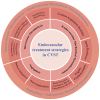Evolution and advances in endovascular mechanical thrombectomy of cerebral venous sinus thrombosis
- PMID: 39439462
- PMCID: PMC11492885
- DOI: 10.7150/ijms.99362
Evolution and advances in endovascular mechanical thrombectomy of cerebral venous sinus thrombosis
Abstract
Cerebral venous sinus thrombosis (CVST) is a rare type of stroke and standard treatment involves anticoagulation. However, for some special CVST patients who are ineligible for anticoagulation or refractory to conservative treatment, endovascular treatment (EVT) may be an effective option. Mechanical thrombectomy (MT) is a commonly used treatment. Compared with anticoagulation treatment alone, MT may result in additional procedure-related complications, however, many studies have shown that it has a high rate of vessel recanalization and lower incidence of related complications in arterial large vessel occlusion stroke. In addition, the applicability of MT in children, patients with deep cerebral thrombosis, and patients with bleeding before treatment has been reported. MT combined with intravascular thrombolysis (IVT) and other multimodal therapeutic strategies, also has a good curative effect, and further research is needed to compare and optimize different treatment strategies. Owing to the low incidence of CVST, randomized controlled clinical trials with a large sample size to explore the safety and effectiveness of MT are scarce. In addition, devices specifically designed for cerebral venous sinus and effective endovascular therapies are currently not well-established. This article summarizes different endovascular instruments and multimodal therapies for cerebral venous thrombosis. We also discuss the limitations, prospects, prognostic factors, and applications in special cases of interventional thrombectomy.
Keywords: Cerebral venous sinus thrombosis (CVST); Endovascular treatment (EVT); Local intrasinus thrombolysis (LIST); Mechanical thrombectomy (MT); Multimodal treatment strategies; Stent.
© The author(s).
Conflict of interest statement
Competing Interests: The authors have declared that no competing interest exists.
Figures



References
-
- Bousser MG, Ferro JM. Cerebral venous thrombosis: an update. Lancet Neurol. 2007;6:162–70. - PubMed
-
- Coutinho JM, Zuurbier SM, Aramideh M. et al. The incidence of cerebral venous thrombosis: a cross-sectional study. Stroke. 2012;43:3375–7. - PubMed
-
- Borhani Haghighi A, Mahmoodi M, Edgell RC. et al. Mechanical thrombectomy for cerebral venous sinus thrombosis: a comprehensive literature review. Clin Appl Thromb Hemost. 2014;20:507–15. - PubMed
Publication types
MeSH terms
Substances
LinkOut - more resources
Full Text Sources

